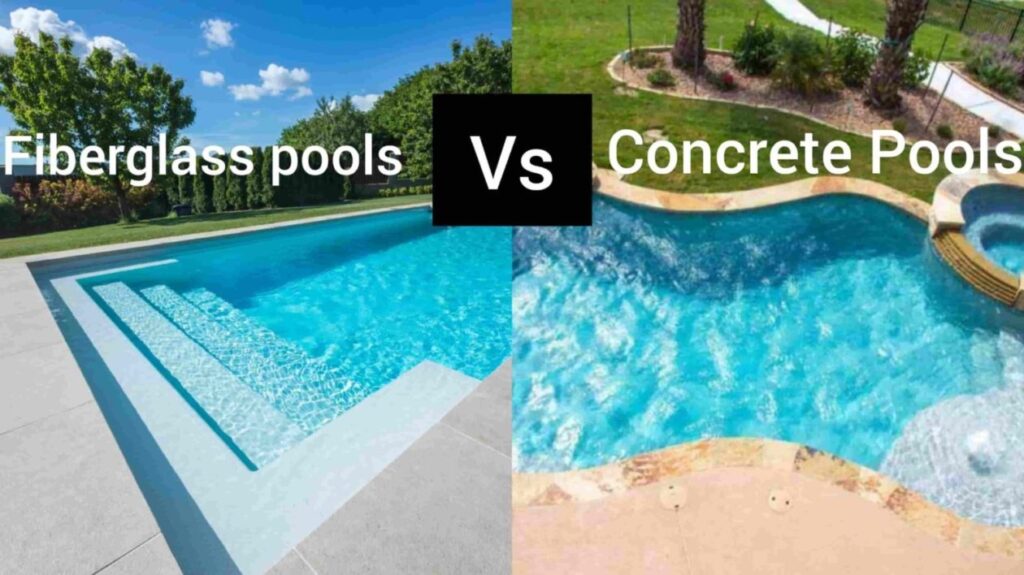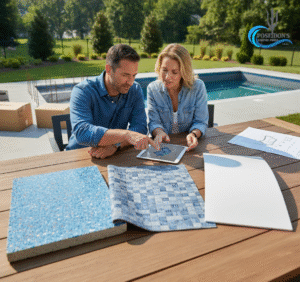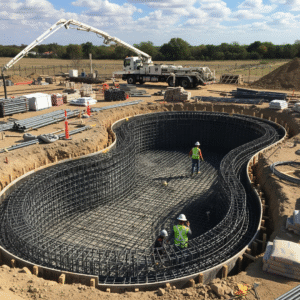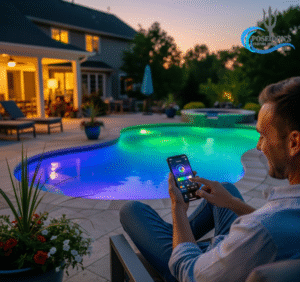Ever wondered why some Pennsylvania pool lovers rave about their backyard pools while others quietly regret their choice? It often boils down to one big decision: fiberglass or concrete. Picking the right pool can transform your summer into a splash-filled paradise—or leave you drowning in maintenance woes. In this guide, you’ll discover the real differences between fiberglass and concrete pools, from costs to upkeep, so you can choose the one that fits your lifestyle and budget. Let’s dive in! Fiberglass vs. Concrete Pools

What Sets Fiberglass and Concrete Pools Apart?
When you’re dreaming of a pool in your Pennsylvania backyard, the material you choose is everything. Fiberglass pools come pre-made, like a giant, shiny bowl dropped into your yard. Concrete pools, on the other hand, are built from scratch, giving you endless shape and size options. Both have their fans, but they cater to different needs. Here’s the breakdown to help you decide.
Fiberglass Pools: The Quick and Sleek Option
Fiberglass pools are factory-molded and delivered ready to install. Think of them as the “plug-and-play” choice for homeowners who want a pool fast. They’re smooth, durable, and low-maintenance, which is why so many busy folks love them.
- Installation Speed: Most fiberglass pools are ready in just 2–4 weeks—check out our pool installation process for the full scoop. Perfect if you’re itching to swim by Memorial Day.
- Smooth Finish: The gel-coated surface feels great on your feet and resists algae buildup.
- Lower Maintenance: Fewer chemicals and less scrubbing mean more time for cannonballs.
But there’s a catch. You’re limited to pre-set shapes and sizes. If you’ve got a wild vision for a sprawling pool oasis, fiberglass might feel restrictive.
Concrete Pools: The Customizable Classic
Concrete pools are the artist’s canvas of the pool world. Sprayed or poured onsite, they can twist, turn, and stretch to match any dream pool designs you’ve got in mind. Want a lagoon-style pool with a waterfall? Concrete’s your guy.
- Endless Design Options: Curves, corners, depths—you name it, concrete can do it.
- Durability: With proper care, a concrete pool can last decades.
- Upgrade Potential: Add tiles, lights, or a hot tub anytime.
The trade-off? They take longer to build (6–12 weeks) and demand more upkeep. That rough surface loves to cling to algae, so you’ll need to brush up on your pool-cleaning skills.

Cost Comparison: What’s the Price Tag?
Let’s talk money—because no one wants a pool that breaks the bank. Pool costs in Pennsylvania vary depending on your yard, location, and upgrades like decking or fencing. Here’s how fiberglass vs. concrete pools stack up, with some extra insight from HomeAdvisor’s cost guide.
Upfront Costs
- Fiberglass: $45,000–$85,000. The price includes the shell, delivery, and installation. Smaller pools lean toward the low end; bigger ones creep higher.
- Concrete: $50,000–$100,000+. Customization drives the cost up, especially if you’re adding fancy features.
Winner? Fiberglass usually wins for budget-conscious homeowners.
Long-Term Costs
- Fiberglass: Lower. The smooth surface cuts chemical use by 20–30%, and repairs are rare.
- Concrete: Higher. Expect to resurface every 10–15 years ($5,000–$10,000) and spend more on chemicals and energy to keep it clean.
Over time, fiberglass often saves you cash. But if you’re in it for the long haul and love a unique design, concrete’s upfront hit might be worth it.
| Cost Factor | Fiberglass | Concrete |
| Initial Installation | $45,000–$85,000 | $50,000–$100,000+ |
| Annual Maintenance | $500–$1,000 | $1,000–$2,000 |
| Resurfacing (10–15 yrs) | Rarely needed | $5,000–$10,000 |
Maintenance: How Much Work Are You Signing Up For?
Nobody wants a pool that feels like a second job. Here’s what you’re in for with each type.
Fiberglass Pools
The smooth gel coat is your best friend. Algae struggles to stick, and cleaning is a breeze—usually just a quick skim and a filter check. Homeowners in Pennsylvania love that fiberglass pools stay ready for spontaneous swims, even after a rainy week.
- Time: 1–2 hours weekly.
- Chemicals: Less needed, saving you $100–$200 a year.
Concrete Pools
Concrete’s porous surface is an algae magnet. You’ll need to brush it weekly and balance chemicals carefully. It’s not backbreaking, but it’s more hands-on—think of it like tending a garden instead of a low-maintenance patio.
- Time: 2–4 hours weekly.
- Chemicals: More frequent adjustments add up.
If you’re the “set it and forget it” type, fiberglass is calling your name. Love a project? Concrete won’t scare you off.
Durability and Lifespan: Which Lasts Longer?
Pennsylvania winters can be brutal, so you need a pool that stands the test of time.
- Fiberglass: Built to last 25–30 years with minimal wear. The flexible shell handles freeze-thaw cycles well, a big plus for chilly PA nights. Cracks are rare, but if they happen, repairs are tricky.
- Concrete: Can last 50+ years if maintained. That rough surface might need resurfacing, though, and cracks can form if the ground shifts.
Concrete wins for longevity, but fiberglass holds its own with less fuss. It’s like choosing between a sturdy old pickup truck and a sleek new sedan—both get you there, just in different styles.
Aesthetics: Which Looks Better in Your Backyard?
Your pool isn’t just for swimming—it’s a centerpiece for summer BBQs and lazy Sundays.
- Fiberglass: Sleek and modern, with a glossy finish that catches the eye. Limited shapes mean less wow-factor for creative types.
- Concrete: Fully customizable. Add mosaics, pebble finishes, or a rock waterfall—your imagination sets the limit.
For a bold statement, concrete steals the show. If clean and simple is more your vibe, fiberglass fits right in.
Climate Considerations: Pennsylvania Weather and Pools
Pennsylvania’s humid summers and icy winters play a role in your choice—check Penn State’s climate tips for more on local weather quirks. Fiberglass pools flex with freeze-thaw cycles, resisting cracks better than concrete. But concrete’s thickness can handle heavy snow loads if reinforced properly. Both need winterizing—draining lines and covering up—but fiberglass makes it slightly easier with fewer nooks and crannies.
FAQs: Your Top Questions Answered
How long does it take to install a fiberglass vs. concrete pool?
Fiberglass takes 2–4 weeks; concrete needs 6–12 weeks—dive into our pool installation process for details. If you’re racing the Pennsylvania summer clock, fiberglass wins.
Which pool type is better for cozy Pennsylvania yards?
Fiberglass. Pre-made sizes fit tight spaces without custom work.
Can I add a hot tub later?
Yes, with concrete—it’s easier to expand. Fiberglass? Not so much.
What’s the resale value impact?
Both boost your home’s appeal, but concrete’s unique designs might edge out slightly for buyers who love luxury.
Making Your Choice: Fiberglass or Concrete?
So, which pool is right for you? If you crave low maintenance, quick installation, and a smooth swim, fiberglass is your match. If you’re dreaming of a one-of-a-kind backyard retreat and don’t mind the extra care, concrete’s the way to go.
At Poseidon’s Custom Pools, we’ve seen Pennsylvania homeowners thrive with both. Fiberglass suits busy families who want more playtime than pool time. Concrete shines for those crafting a legacy feature for their property. Whatever you pick, we’re here to bring it to life—tailored to your yard and your vision. Curious? Explore more with Pool & Spa News insights for the latest trends.
Ready to take the plunge? Drop a comment below with your thoughts, share this with a friend who’s pool-shopping, or chat with us for free at Poseidon’s Custom Pools. Your perfect pool is waiting!




